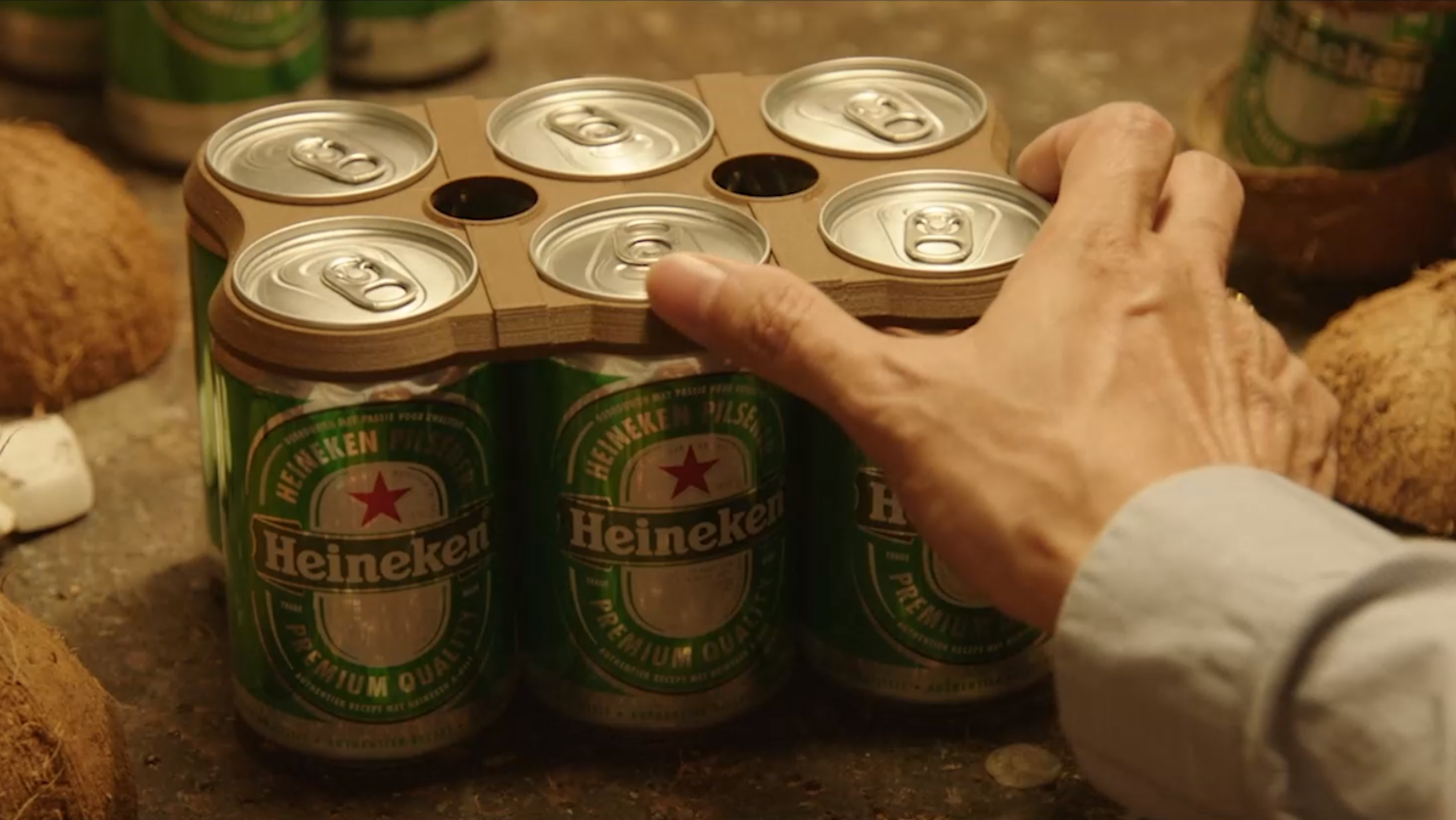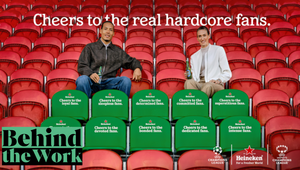
How The Heineken Collective Is Trying to ‘Brew a Better World’

In 2021, dentsu and HEINEKEN UK created The Heineken Collective, a community of stakeholders, to raise awareness of inclusion, diversity and sustainability (ID&S) throughout the brand’s marketing. The aim is to build a more inclusive, sustainable marketing ecosystem across media and creative in partnership with dentsu X (Red Star) and Dentsu Creative.
The brewer was the first advertiser in the UK to use the dentsu Media Carbon Calculator, using the results to create benchmarks to help reduce the carbon emitted from its marketing activities.
ID&S requires ongoing commitment, and dentsu continues to work with HEINEKEN UK and all its agency partners to embed these principles at the heart of every media touchpoint, sharing and learning from one another.
LBB’s Alex Reeves speaks to Olya Dyachuk, HEINEKEN data-driven media director and Lee Mabey, dentsu X managing partner, to find out more.
LBB> What was the initial thought that led to The Heineken Collective being created?
Olya> The HEINEKEN ‘Brew a Better World’ strategy was created to drive positive change. It informed our approach within the Media and Marketing department where we decided to make a significant step change in how we are driving diversity, equity and sustainability throughout the organisation, and how we can do it to drive the ‘Brew A Better World’ agenda through media and communications.
The Heineken Collective came about because we didn't want to do just a variety of ad hoc activations, preferring a way to make it into a cohesive framework.
Lee> The Heineken Collective was created to support HEINEKEN UK’s wider ‘Brew a Better World’ agenda. Rather than look at rudimentary targets such as minimum investment levels into diversity and sustainability partners and technology, we believed it was important to create something which had longevity and went beyond traditional annual planning cycles. Driving positive change needs a longer-term vision, therefore we created a task force that would keep us on track to deliver against short-term and long-term metrics.
LBB> What kinds of people have joined the collective and what skills and perspectives do they bring?
Lee> We believe a group which was formed to champion diversity should feature individuals with a range of perspectives. Therefore, we included DE&I leaders from dentsu and HEINEKEN UK, as well as dentsu’s global social impact lead. This would ensure we were looking beyond activations and focusing on where our actions and outputs fitted into a wider ecosystem. This was critical for the success of the Collective, since it meant we had people who could provide industry best practice and create a better workplace for our teams. For example, our DE&I lead Nicole Basra shared information on how dentsu created its transitioning at work policy, and HEINEKEN UK invited dentsu to participate in internal inclusivity events.
Olya> The working group featured both HEINEKEN UK and dentsu people that could drive the agenda forward. It was great to find partners in crime in the dentsu team, as its social impact agenda is very much aligned to ours. The Heineken Collective first comprised our in-house media and dentsu teams, and the HEINEKEN UK head of diversity, equity, and inclusion.
This working group was responsible for developing, delivering, and testing the project. Then in year two, we developed a more organised approach which in turn created a key framework, with ongoing work streams and strategic directions. We also widened the net to include all our agency partners covering all areas of activation including influencer and social. It's been great to have all parties working together and driving the change because just media is not enough.
LBB> What were the main decisions in the process of building out the aims and structures of the community?
Olya> We wanted to first find the ID&S proof points and then take it to the wider community of agencies. It was important to showcase to the business what we could deliver. The second layer was understanding what are the areas that we can focus on and what we can control. We started with what we can do such as working with diverse talent and working with sustainable partners like WeAre8 or Loop-me.
LBB> What are some areas in the ID&S sphere that are particular priorities for the collective right now?
Lee> Right now, we are focused on ensuring all brands have factored ID&S into their annual plans. For some brands, this is an extension of work they are already doing, such as this year’s Eurovision activation and Brighton Pride sponsorship for Strongbow or our sustainable food partnership with MOB Kitchen for Inch’s. For others, it is starting them on the journey to be inclusive and / or sustainable. But everything we do must be centred on audience insights. Doing things to tick a box is wrong, so for some brands we know we need to invest time to embed ID&S.
LBB> Can you talk about how The Heineken Collective worked to help reduce the carbon emitted from HEINEKEN's marketing?
Olya> When we can prove our work and take it into creative and production, we are ready to merchandise and talk about it. Transparently we've been trying to be careful internally and externally because we want to make sure we have the proof before we go and shout out loud.
However, we have our proof now and The Heineken Collective is sharing its experiences. This includes ad hoc activations such as running content with diverse talent alongside the strategic workload such as building carbon calculation methodology with dentsu but also the work we are doing in carbon measurement with ISBA.
Lee> HEINEKEN UK was one of the first advertisers to use the dentsu Media Carbon Calculator. All of our media 2022 activity was measured at a brand and portfolio level to identify the carbon emissions by channel. Unsurprisingly it revealed digital has the highest carbon emissions. But instead of removing these high-performing channels off our plan, we decided to focus on how we can reduce the impact of our activity, such as reducing the file sizes and partnering with sustainable ad tech partners.
LBB> What are some other ways that you work to embed DEI&S principles into the heart of every media touchpoint?
Olya> We have been constantly evolving our ID&S work and have recently integrated this into our annual planning process. We created a Diversity, Equity, Inclusion and Sustainability checklist which is now part of annual planning for every brand in our portfolio. Within that, every brand is defining how ID&S plays a role in their plans. For some brands it's easier – Inch’s operates in sustainability and Heineken leans into inclusivity. However, every brand must have an ambition to include either from a strategic or executional perspective. Every brand in our portfolio should be able to ensure we are buying more sustainable media and that we are using diverse talent in our communication.
Lee> The ID&S checklist has meant all agency and client stakeholders consider early in the annual planning process how we can make positive societal change. This has allowed us to review changes we can implement at a brand and portfolio level. We are always actively scoping out new platforms, technologies, or partners which can help HEINEKEN UK deliver on its ‘Brew a Better World’ strategy. I believe this is still a nascent area in UK media, therefore we must stay alert to how we can evolve our media operations to be even more inclusive and sustainable.
We also ensure ID&S partners are invited to our annual Media Partner Day. This is an event where the brand teams present their vision for the year ahead and the marketing challenges partners can help to solve. By briefing all partners at once, we create an egalitarian, transparent playing field. From an inclusivity standpoint, it made sense to bring say queer-directed publishers or sustainable ad tech partners together with established platforms and broadcasters. It also gives rise to better quality responses since these partners understand the overall brand story, and not only the elements focused on ID&S initiatives.













